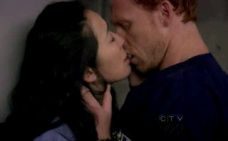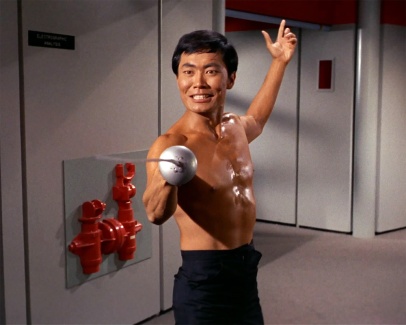
For all of you out there who are getting on Takei’s case about his take on Sulu in Star Trek Beyond, I would ask that you take a step back for a moment. As an artist, I recognize your right and visceral need to defend your work and creative choices. I also understand why you may feel hurt and a little betrayed. But I believe there is another perspective you should consider.
As pointed out in All Ghosts Are White, I grew up at a time where there were few strong Asian male role models in movies or Television. Takei’s Sulu and Jack Soo’s Yemana on Barney Miller were the only1 non-stereotypical main-cast actors on mainstream American TV. I latched onto both like a drowning man, but particularly Sulu. More on that later. My love and admiration for Mr. Takei has only grown over the years not only for his creative output, but for his integrity and keen social sensitivity… despite the fact there was never a Captain Sulu movie or TV series (shame on you Paramount/CBS!).
The typical response I used to get from my (white) friends, when I would express my disappointment at the lack of Asian male representation in media would be along the lines of:
“But you have Bruce Lee! And Sulu!”

…and then they’d name a bunch of Asian women. I would then have to point out that Bruce Lee had been dead for a long time, and Star Trek only existed in re-runs for even longer, and that all the women they mentioned had white male love interests.2 I touched on the very long history of fetishization of Asian women in my previous article.

When you grow up and the 100 Sexiest Men never, ever looked anything like you; and when every star on TV or in movies doesn’t look like you, it tends to have an impact on your self-esteem.3 If you are overweight or your hair color is off, you can work on those things. Skin color, nose and eyes can’t be.4 People love to say we live in a post-racial era, but it wasn’t true then, and it isn’t true now. Everyone sees race, even if only their own is important to them.
 Through the ’80s, the typical portrayal of Asian men (if a show bothered to cast one at all) was of the “no tickee, no laundry” or the Korean convenience store owner, or of course the restaurant owners that stayed open on Christmas.
Through the ’80s, the typical portrayal of Asian men (if a show bothered to cast one at all) was of the “no tickee, no laundry” or the Korean convenience store owner, or of course the restaurant owners that stayed open on Christmas.
My one complaint about Bruce Lee, (though it wasn’t his fault) was that he didn’t live long enough to portray fully fleshed out characters. He created a new Asian male stereotype: spiritual but sexless martial-arts master.4. Also, he set the bar so high that it was virtually impossible to follow in his footsteps. After his death film makers scrambled for a replacement, so we got Bruce Le, Bruce Li and many other inferior clones. Until Jackie Chan made a name for himself, Asian men couldn’t be anything other than a Bruce Lee clone. And despite Jackie Chan’s, and later, Jet Li’s, success, they were never able to capture the imagination of the American viewing audience the way Lee had. When Hollywood figured out they could hire white martial artists, or could simply hire Hong Kong fight choreographers and teach white actors Kung Fu, that ended the hiring of Asian men as leads in American action films.6

This is why Sulu was such a powerful and enduring symbol. Not only was he handsome, highly competent and brave without having a stereotypical accent (just like me!), but he was allowed to be virile and sexy. Though he never had an onscreen romance (unfortunate), it wasn’t hard to imagine the ladies were lined up. This wasn’t just a rarity on American TV, it was a goddamned unicorn.
While the portrayal of Asian male sexuality has gotten better, particularly within the last 10 years, it is still very rare.
I’m going to be blunt here. First, I have zero problem with showing gay Asian male characters. However, the emasculation of Asian men (and minorities) goes literally back to the birth of modern film. Though it should absolutely not be considered as such, calling or portraying a character as gay is a form of emasculation, because strong, virile, self-determined minority characters are a threat to the sexual supremacy of white men. The film Sweet Sweetback’s Baadasssss Song started a trend to reclaim black male sexuality and power, but there has been, to date, no Asian equivalent. The overwhelming examples of inter-racial relationships on television have been white-man-on [x] or black-man-on-[x]. I’m not saying straight Asian men have to get equal numbers, but can Asian men hooking up with any women at least be on par with number of white guys hooking up with Asian women? To see a white woman choosing an Asian man really stands out (thank you Walking Dead, thank you Rachel Bloom),7 but it really shouldn’t.
In Conclusion
More than anyone, George Takei has the right to be protective of the character; he was the one who made that character what it was, brought him to life and gave him qualities unseen on American television up to that point.8 Not only that, but as I pointed out in the Ghost in the Shell article, I believe it is the right of those affected to be able to frame the argument. So with all due respect Simon (and I love your work), while I applaud your intent, I have to side with George.
Live long and prosper.
p.s. What do I think about Sulu being gay in Star Trek: Beyond? I couldn’t care less. Why? Because they’ve changed and done so many things with such casual disregard for cannon or everything that makes the characters the characters, that one more change doesn’t matter in the least. This is not my Star Trek, and that’s fine. I still have all my blue-rays. BTW, Simon, remember your rant about Phantom Menace in Spaced? What goes around comes around, buddy. Don’t want to deal with a passionate, if sometimes overzealous fan base, then don’t work on the property that invented modern fandom, and that wouldn’t even exist without that fandom.
1. Hawaii Five-O was also a notable example of diverse casting, but there was a distinctly exotic flavor to the casting from a mainland POV. Magnum PI was another, but with the same caveat as Five-O, plus the fact that no main characters on that show were Asian or Hawaiian. Kung Fu starred a white man, despite the fact that I love it. A fake Asian man was better than no Asian men as far as I was concerned. But also keep in mind that his character, despite being played by a white man, was scrupulously sexless.
2. Nurse Ogawa/Keiko O’brien in Star Trek: The Next Generation/Deep Space Nine, Ling Woo (Lucy Liu) in Ally McBeal are the ones that come to mind. But it also happened on M*A*S*H (unavoidable given the setting and, well, reality, so I’m willing to give this one a pass), Magnum PI, NCIS, Battlestar Galactica (just everyone was in love with Boomer… except an Asian man) and more than I care to remember. As far as movies goes, someone made a list here. Notably absent is South Pacific. I guess the list maker isn’t a fan of musicals.
3. Unless you resort to much surgery.
4. You people realize Asians aren’t actually yellow, right? Also, this stereotype continued until Hollywood could hire white martial artists to star in American films, at which time Asian men were relegated to the status of bad guys or henchmen. By the way, Shang-Chi came out in 1973. It wasn’t until Amadeus Cho was elevated to full-Hulk status in 2015 before we got another Asian male headliner. Still waiting on the MCU or DCU. I think it’s going to be a looooooong wait.
5. About 10 years ago, I dressed up as Indiana Jones for Halloween. The response I got from some of my white friends was that Indiana Jones isn’t Asian. Well, Harrison Ford wasn’t really an archeologist either, but it was okay for him to play the character! This is to say how important it is to have Asian male heroes and role models.
6. Jackie Chan made The Big Brawl in 1980, followed by a bit part in The Cannon Ball Run in 1981 then went right on back to China. He didn’t have another big American film until Rush Hour in 1989. His character, creatively enough, was named Lee. Jet Li’s American debut was as the bad guy in 1998’s Lethal Weapon IV. Next was Romeo Must Die in 2000, then The One and Cradle 2 The Grave both in 2001, after which he’s only had one other starring role with 2005’s Unleashed. Even with Romeo and Cradle, he really wasn’t the star but shared equal screen time with DMX.
7. By contrast, in the ‘90s when there was a brief resurgence of HK action stars due to the cult status of HK films, not only were these characters neutered (Jet Li’s one kiss in Romeo Must Die was cut from the film due to negative audience reaction… I mean, how the fuck can you have a character named Romeo and not have any Romeoing? Or in The Replacement Killers, when Chow Yun-Fat leans in to kiss Mira Sorvino, he totally misses her face. With aim that bad, no wonder he was being replaced), but Hollywood quickly lost interest in the trend. Both pretty much went back to China, with Li only occasionally doing bit parts in Hollywood productions.
8. Sorry, but no. I’m not going to give it to Bruce Lee for his portrayal of Kato, no matter how awesome he was, as he was still the Green Hornet’s man servant. Sulu wasn’t anyone’s damn servant, and in several instances took command of the Enterprise and did a friggin’ awesome job.

Heck, I’m a mulatto woman and I think Asian men can be very sexy. I know a lot of non-Asian women would agree with me. Daniel Dae Kim is such a fox, I want to bang my head against a wall. But anyway, I’m with Takei on this one: give Sulu a non-Asian female love interest. That would be just as groundbreaking as making him gay.
Sheesh, who does Simon Pegg think he is? Why are filmmakers going to this prick for advice on films that he wasn’t even around to make in the first place? First he’s a consultant on “The Force Awakens” (which was forgettable) now he’s a screenwriter for “Star Trek Beyond”. He whines and rants about the prequels and trashes anyone who likes them, then throws a hissy fit when true Trek fans vote “Into Darkness” as the worst Trek film. What a brat.
LikeLiked by 1 person